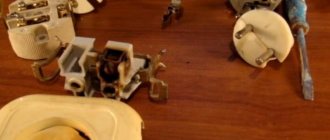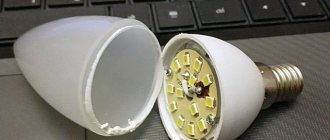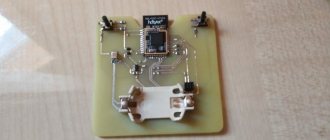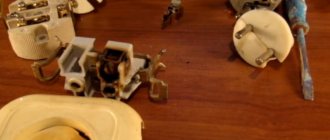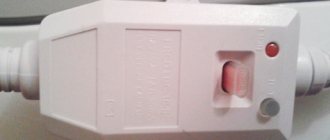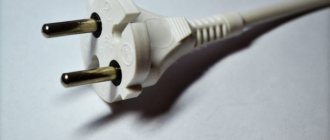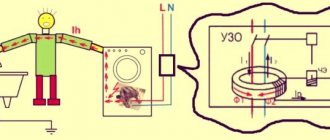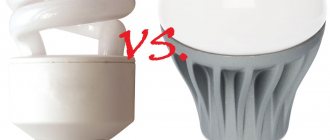Reasons why light bulbs explode when the lights are turned on
Very often it remains a mystery to us why a light bulb suddenly explodes when we turn on the lamp. It is necessary to try to get to the bottom of the true reasons for this phenomenon. The first thing that comes to mind is that we were given defective products in the store. But if light bulb explosions occur with enviable regularity and your life has turned into the life of a soldier in the front-line zone, and you are already tired of changing light bulb manufacturers, you need to dig deeper.
It is likely that explosions are the result of electrical surges or something is wrong with the wiring in the apartment; perhaps some design features of the lampshades affect this. The power of the lamp and the lighting device may well not match. There are many reasons and all of them should be studied in detail.
Lack of ventilation in the ceiling
Very often you come across lamps equipped with closed shades. If you screw an ordinary lamp into such a lamp, you can expect it to explode soon. Why? It’s just that when the light bulb is turned on, it gets very hot, and if the lampshade is partially or completely closed, then there is nowhere for this heat to escape. Hence the inevitable overheating of the light bulb.
Constantly heating and cooling, the glue on the base is subject to destruction. As a result, the base will move away from the glass bulb. As soon as air gets access to the flask, an explosion will occur.
To ensure air flow around the entire perimeter of the lampshade, you can drill holes. This will ensure air circulation and prevent the light source from overheating. If the lampshade is made of glass, then in the place where the mount is installed, you can make a small gasket of non-flammable material. This will provide a similar effect.
Electrical voltage
A very common reason for light bulb failure is sudden voltage changes. To smooth out their consequences, stabilizers are often installed that equalize the voltage within the electrical network. This allows you to extend the life of the devices.
To extend the life of light bulbs, you need to connect them correctly. Lead the phase wire to the plate installed in the center of the socket, and secure the neutral wire to the side plate.
Low quality light bulbs and lighting fixtures
Don't try to make a profit when buying lighting fixtures. This is the surest way to replace them quickly, since such devices are unstable and very often explode.
Incorrectly selected power
If the power of the light bulb installed inside the chandelier does not meet the requirements of this device, it is no wonder that it will explode. If you can’t install a classic incandescent lamp in a lamp, then what’s stopping you from installing an LED lamp instead? The light is brighter from it, and it requires less electricity.
Cause of halogen lamp explosion
Halogen light bulbs often explode because they are simply connected incorrectly. You should always familiarize yourself with the installation diagram provided by the manufacturer. If all points are connected to one cable, the light bulb will certainly explode.
You should never handle a halogen lamp. Fingers leave greasy marks on the surface. These places gradually darken under the influence of temperature, which will later lead to an explosion. The reason for this phenomenon is the uneven heating of a clean surface and a dirty one.
What else could cause a lamp to explode?
Constant temperature changes are another reason for the destruction of incandescent lamps. Such changes allow air to enter the interior of the flask and excess pressure leads to an explosion. To avoid such trouble, it is better to purchase LED lamps or gas-discharge lighting devices.
Excess moisture in the room also adversely affects the lamps, which leads to their damage.
The chandelier glows or blinks when the lights are off
In some cases, the bulbs in a chandelier may glow or flicker slightly even when the switch is off. It would seem incredible, but in fact there is nothing surprising in this and everything is understandable.
If an incandescent lamp is illuminated, then there are two problems that are superimposed on one another:
- incorrect connection;
- bad wiring.
It is obvious that the switch is not installed in a phase break, but in a zero break. Thus, even after it is turned off, there is a phase on the lamp. If the wiring is working properly, then in this case everything will work fine - the circuit is open, the lamp does not light up. But there are problems with the wiring. If the insulation on the neutral wire leading from the lamp to the switch is damaged, current will leak and the lamp will begin to glow or occasionally flash (blink). This occurs when installing a compact fluorescent or LED lamp.
And they blink because no matter how small the leakage current is, it slowly charges the high-voltage capacitor. As soon as the voltage across it reaches a certain value, the driver will start and light the lamp. The capacitor will immediately discharge, the light will go out, and the process will repeat.
Healthy! If the LED lamp is dimmable, then it may also glow dimly rather than flicker.
The next reason why LEDs and fluorescent lights blink is the backlight in the switch. The light bulb or LED backlight is powered through the lamp. Their current consumption is small, and an incandescent lamp will not react to it in any way, but if the indicated light sources are screwed in its place, they will begin to blink. The reason is the same - slow charging of the capacitor through the backlight and driver start-up and rapid discharge.
And the last option is a dimmer. To work with dimmable LED light bulbs, you need a special multi-wire dimmer, which is powered via an independent line. If a two-wire one is installed for incandescent lamps, then it will be powered through the lamp with all the ensuing consequences.
How to get rid of this unpleasant effect? In the first example, you need to fix the wiring and put the switch where it belongs - in the phase break. In the second case, you will have to get rid of the backlight or install an incandescent lamp. In the third, install a dimmer to work with LED lamps.
Errors in lamp manufacturing and their incorrect use
Production quality
The reason why household lighting bulbs explode may be hidden in them themselves. There are two options here. The first is low quality products. The modern market of electrical equipment and accessories is flooded with products of dubious manufacture. It is popularly called “Chinese”, although it can also be held in other Asian countries. Local manufacturers export lamps at a very low price and, in order to make production profitable, use low-quality raw materials for production. These may be unsuitable alloys, glass, or parts. As a rule, such a manufacturer honestly tries to make a good lamp, but is forced to save money. Because of this, minor discrepancies with technical specifications arise.
Russian manufacturers, on average, produce better products, but are still inferior in quality and functionality to world-famous Western brands. This is also related to economic considerations in production.
Technical requirements of the lamp
It is worth noting that user errors are often the answer to the question of why lamps explode. Many people do not pay attention to the technical information that manufacturers provide on the packaging or in the data sheet of lighting devices. It indicates the recommended voltage at which safe and reliable operation is guaranteed. Accordingly, when installing a lamp with increased or decreased operating voltage, conflicts and problems arise in the network.
Why does a switched off energy saving lamp blink?
There were no problems until energy-saving compact fluorescent lamps (CFLs) with an electronic ignition circuit appeared in large quantities. In such lamps, the power circuit is designed in such a way that even if one wire (usually a phase wire) is broken by a backlit switch, a charge can accumulate on the filter capacitor.
As a result, the voltage will increase so much that it is enough to start the circuit, and the lamp will light up for a moment. This manifests itself as periodic blinking of the energy-saving lamp after switching off . The same effect can occur in LED lamps.
I’ll immediately make a reservation that blinking can occur not only due to the backlight, but also due to other reasons - poor wiring insulation, lamp malfunction, a very long wire from the switch to the lamp.
For example, when a phase wire is open, along its entire length from the lamp to the switch contact, this wire represents an antenna. And if the wire is long (20-30 or more meters), and another wire passes nearby, on which there is a phase, then a phase is induced on the hanging wire, the power of which is enough to flash a fluorescent or LED lamp.
Looking ahead, I will say that the recommended method of getting rid of flashes will work perfectly in this case, since its nature is the same - a weak potential comes to the phase wire, which slowly accumulates on the filter capacitor, and after some time the voltage on the capacitor (tens of volts) becomes sufficient to run the electronic ballast circuit.
An energy-saving lamp may also blink or not blink, depending on the specific type of lamp and manufacturer. Recently, manufacturers have been refining the lamp circuit to solve the problem described here.
Expert opinion
Viktor Pavlovich Strebizh, lighting and electrical expert
Any questions ask me, I will help!
Domestic consumers, for the most part, have already learned to more or less correctly select LED lamp models based on parameters such as color temperature, luminous flux and scattering angle. If there is something you don’t understand, write to me!
For what reasons do light bulbs in a chandelier often burn out?
Let's figure out why lamps can often fail. The first reason is low quality products. Many people buy Chinese-made lamps, and such purchases, as you know, are a lottery: it may work, or it may not.
However, there are a number of other factors. These include high voltage in the electrical network. As you know, it should be 220 volts, but most often it is unstable and “dances” in the range of 210-235 volts. Such deviations are included in the standards and are therefore taken into account in the production of lighting devices. Such jumps have a negative effect on the tungsten filament.
Even a slight deviation can cause its failure. And the point here is this. The thread heats up to a temperature of 2500 degrees, and as the voltage increases, the metal begins to actively evaporate. Therefore, the thread becomes thinner and breaks. This can be prevented in various ways:
When purchasing a new light source, pay attention to the voltage range for which it is designed. It is best to choose a product where it is up to 245 V
After all, the higher the upper indicator, the less likely it is that the lamp will fail, that is, burn out. Buy energy-saving light bulbs. They are not “afraid” of power surges. Get dimmers, voltage stabilizers, overvoltage sensors or special protective blocks.
In addition, the reason that the light bulb burns out may be a faulty socket. Most often they are made from low quality plastic. Moreover, some cartridges are designed for power up to 40 Watts (they are used in multi-lamp lamps). Consumers may simply not know this, so they purchase them, and then screw in a 60, 75 or even 100 Watt lighting fixture. As a result, the cartridge simply cracks and burns out.
But even if you comply with all technical standards, it happens that the lamps still burn out and quite often. Another reason why this happens may be oxidation of the cartridges. Signs of this problem are:
- crackling sound when you turn on the light;
- change in light brightness over time.
What to do in this case? It is necessary to monitor the condition of the cartridge and clean it if necessary. If it “looks really bad,” then the best thing to do is replace it.
In addition, there are a number of other reasons why lamps burn out quickly. Many consumers, trying to save electricity, always turn off the lights behind them. True, they do not take into account that it is also impossible to turn it on after a couple of minutes. The fact is that when electricity is supplied, the current is much greater than when the light bulb is simply on. Therefore, if you “flick” the switch back and forth, you can burn the tungsten filament. Most often, a rupture occurs at the moment when current is applied to it.
Another reason is problems with the switch. If it becomes unusable, replace it immediately, as it can cause a short circuit, which will cause the lighting fixture to burn out.
The next problem is low temperatures and the influence of various mechanical influences. If you plan to use incandescent lamps in places where the lamp is exposed to mechanical stress, for example, increased vibrations, then remember that tungsten filaments are very sensitive to them. Moreover, starting at low temperatures reduces the metal resistance, which leads to filament burnout.
The next reason is an incorrectly selected connection diagram. To save money, some consumers use a serial connection of all light sources to one wire. If the contacts are faulty, the cartridges will begin to oxidize, the load will increase, which will ultimately lead to a voltage drop.
Typical malfunctions of the chandelier
Malfunctions associated with chandeliers equipped with remote control have characteristic features. The main breakdowns that often occur:
- Does not respond to the remote control;
- Does not respond to a stationary switch;
- A certain number of LEDs or halogen lamps do not light up;
- Several commands are executed from the remote control and stops responding to commands;
- Does not respond to either the remote control or the stationary switch.
No remote response
There may be several reasons. Take your smartphone, turn on camera mode, point the remote control at the camera and press the buttons. If it works, you will see a bright white blink on the screen. If not, then it needs to be repaired.
You can determine the cause of the malfunction by performing the following steps:
- Checking batteries;
- Checking the tracks of the remote control board;
- Checking and cleaning the board contact pads.
You need to open the compartment where the batteries are installed and take them out. Check the battery voltage with a multimeter; if it is below normal, replace the batteries.
If the light device no longer responds to the remote control, take it and disassemble it, carefully look at the traces of the printed circuit board, solder joints - there may be ring cracks around them, if there are any, solder them. Clean the contact pads.
If the remote control works, then the reason is in the chandelier control controller. Remove the chandelier, take out the controller unit, disassemble it and you will see the RF receiver board. Check all capacitors on the board and solder contacts; it is advisable to replace all capacitors, since over time their capacity decreases and they leak. Check the contacts near the photocell, they are often lost; if necessary, solder them. Check the Chinese photocell for cracks.
If all detected problems are corrected, but the RF receiver does not work, it means that the RF receiver chip has failed. Replace the chip or buy a new RF receiver.
Incorrect operation from the remote control
If all modes work from a stationary switch, and from a distance the selected modes work first, and then the light element stops responding to commands, then the problem is in the control controller board. There are metal-ceramic capacitors on it that resemble thick pads - they are the ones that need to be replaced.
Problems with the fixed switch
If the chandelier turns on from the remote control and does not respond to the stationary switch, this means that the control controller is working properly and so are the electronic transformers. Otherwise, it would not work from the remote control, provided that the remote control and the control controller unit are in good working order. You need to take a multimeter and ring all the connections of the switch to the controller unit, having first de-energized everything. Find the break and fix it.
LEDs and lamps do not light up
If all the LEDs are not lit, it means the control controller is not working. If a certain number does not light up, it means that one or more LEDs, or one of the two electronic transformers that powers its line of LEDs, has failed. The LEDs are connected in series, and if one burns out, the circuit breaks and the others do not light up either. Check the LEDs. Find the burnt one and replace it.
If halogen lamps are used, the electronic transformers to which they are connected must be checked. Then check the lamps themselves: they are usually connected in parallel and can be easily checked with a multimeter. Find the faulty one and replace it.
The lamp does not turn on
If the chandelier does not operate either from the control panel or from the stationary switch, most likely the chandelier control unit has failed. Usually, the chandelier control unit fulfills its purpose very reliably, but due to voltage drops, the microcircuit of the control unit fails, and the conductive paths on the board burn out. Open the unit while holding the board with one hand. In your other hand, take a magnifying glass, with which you carefully examine the metallized tracks for damage and microcracks. Damaged items can be restored.
Diagnostics and repair of LED chandeliers with a control panel does not cause any particular difficulties. You can save a significant amount of money by repairing the chandelier yourself and without the help of a specialist.
Changes in temperature and humidity
The rarest reason, but it also occurs. In the case of a serious difference in temperature, the reason lies in the excess pressure that appears inside the bulb, which results in the explosion of the light bulb. If the contacts in the cartridge become damp, the current in the circuit increases, up to a short circuit. If you switch to more modern lamps that are resistant to both temperature changes and too high voltage in the network, the first problem can somehow be circumvented. But if the problem is that the contacts are damp, this is much worse, and you won’t be able to get away with a simple replacement.
LED lamp
Today the most promising are LED lamps. Firstly, they are more durable than incandescent lamps, and secondly, they are many times more economical in terms of power supply. They are, of course, more expensive, but in the long run they fully pay for themselves. In addition, sellers usually give them at least a one-year warranty.
Luminescent and other gas-discharge
These types of light bulbs explode much less often. The bulb of a linear fluorescent lamp or CFL (energy-saving) most often explodes due to manufacturing defects or mechanical damage.
But this can also happen due to the failure of the choke or electronic ballast, as a result of which a high current will flow through the lamp, the discharge in it will heat the gases to a high temperature and the thin glass cannot withstand it and bursts. Therefore, if your light bulbs explode one after another in a linear fluorescent lamp, check the serviceability of the ballasts; if they are faulty, replace them.
It is also impossible to allow water to enter, because the bulbs of gas-discharge light sources heat up, and a sharp temperature change can be detrimental, including for HPS and DRL.
Important! What to do if an energy-saving lamp breaks, read the article:
The light bulb exploded - how to safely remove the base?
If a light bulb explodes and there is a base left inside the socket, do not rush to pull it out with your bare hands. The sockets of the old Soviet type are easily unscrewed from the lamp; new imported lighting devices are made of a monolithic design. If it is possible to unscrew the cartridge, unscrew it and use needle-nose pliers with an insulating handle to remove the base. The average price of this tool is 150–250 rubles. The needle-nose pliers should fit comfortably in your hand.
The edges of the tool are available with straight and curved jaws. For working with electronics, we recommend having both options in stock. Needle-nosed pliers with an insulating handle eliminate the possibility of cutting from glass debris or electric shock when removing the base. When removing the exploded light bulb, turn off the light on the panel. Using needle-nose pliers, smoothly rotate the base and unscrew it from the socket.
When removing parts from a chandelier and other lighting fixtures located at a height, we use a ladder and involve an assistant, since sometimes the base is fixed quite tightly in the socket, and it is impossible to get it out alone.
A light bulb exploded (the lamp broke, burst): why, what to do?
- Don't turn on the air conditioner. Mercury from a light bulb can settle inside and, after cleaning, spread throughout the room.
- Do not throw waste down the drain.
- Do not use a vacuum cleaner for cleaning - mercury particles may remain inside it.
- Take children and animals out of the room, and ask other family members not to enter until you finish cleaning.
- Do not touch the fragments with bare hands. Use rubber gloves, or better yet, a thick sheet of paper, cardboard, rag or paper towel.
Reason No. 2 – network voltage
This reason should be discussed in more detail, since it is caused by several factors. The question may arise as to why household appliances and electronics do not burn out during sudden power surges. Everything is simple here - all modern devices are equipped with stabilization or protective devices that are quite capable of containing short-term sharp surges in voltage, and after the surge, working, for example, at an increased current, albeit with a load, they continue to work quite tolerably.
But with incandescent lamps it is a little more complicated. The voltage from the network goes directly to the device, without any protection, and therefore such a light bulb takes the entire blow.
In addition, there is one little secret, knowing which, you can make sure that light devices with an incandescent filament continue to work even after power surges, provided, of course, that they are not too large.
Elimination
Anyone who has encountered connecting a cartridge to the network knows that power comes to it through two wires. But usually no one attaches importance to which wire is connected to which contact.
But this is important, and manufacturers of incandescent lamps produce them according to a certain scheme. It provides for the fact that the phase wire must approach the central contact of the cartridge, and the zero wire must approach the peripheral one
It is the correct connection that can help an incandescent lamp not explode.
Reason #3 – bad contacts
Very often, the cause of an incandescent lamp explosion is poor contact. For example, if the socket connections are not tightened properly, this will again lead to heat and the lamp will explode.
It makes sense to inspect the input cabinet, and most carefully, the connection of the neutral wires, since this is the weakest point and a very common cause of various troubles. If there is poor contact between the neutral wire and the neutral block, there is a constant change in the voltage in the network, and sometimes quite sensitive.
Such jumps are especially noticeable if any powerful device is turned on on the same pair (phase-zero). Just when it is turned off, a sharp surge in voltage occurs due to the fact that with poor zeroing, the voltage in the network does not have time to stabilize. As a result, the weakest link in the chain usually fails, and this, naturally, is an unprotected incandescent lamp.
Elimination
Treating such “sores” is quite simple. To prevent the device from exploding, it is necessary to monitor the condition of the contacts, switches, and cartridges. If this is not done, the lamps will continue to burst.
To prevent this, it also makes sense to install a dimmer instead of a switch and a stabilizing device at the input.
“>
Reason No. 1 – ceiling ventilation
When an incandescent lamp operates, a lot of heat is generated. Naturally, it needs a way out, and if you imagine that there is a dome over a working lighting device that prevents heated air from rising upward, trapping it, then you can understand that the lamp is constantly overheating, and this happens quite quickly. This will not happen if you install LED lamps, since they have good heat transfer.
In this regard, with constant temperature changes, the base is separated from the bulb due to the destruction of the adhesive base, and the moist air that gets inside when heated again destroys the lamp tube. As a result, naturally, it ends up inside the flask and an “explosion” occurs.
The fact is that inside the light bulb there is either a vacuum or a special gas that does not expand when heated strongly, and ordinary air simply bursts the bulb from the inside, and it bursts.
Eliminating the cause
It is easy to eliminate such a cause. The ceiling ventilation needs to be improved. If it is metal, simply drill a few neat holes in the back to restore air circulation.
Perfectly ventilated lampshade. This way the lamp will heat up less
If the lampshade is glass, then at the junction of the fastening plastic washer with it it is necessary to lay 3-4 small pieces of dense non-flammable material, thereby ensuring the outflow of hot air.
LEDs
High-quality LED products definitely do not explode. But cheap products from Chinese brands come from time to time. By definition, LEDs cannot explode, but an LED lamp is equipped with a power supply with a rectifier, which includes a filtering electrolytic capacitor, so it can explode. What is the reason?
To save money, the Chinese install elements designed for low voltage, for example, 63 Volts instead of 400. Under normal conditions, they still function somehow, but at the slightest deviation from the rated voltage upwards, they explode. As a result, the lamp housing may also rupture (although this rarely happens).
So we looked at the main reasons why light bulbs in a chandelier and other lamps explode. As you can see, lamp explosions mainly occur due to problems with the voltage in the network, poor quality assembly, or improper operation. We hope that the article provided was useful and interesting for you!
Many people have encountered a problem when, when turning on the light in a room, an incandescent lamp suddenly explodes with a bang. Naturally, this is unpleasant - there is fear, and darkness in the apartment, and even the base from a burst lighting fixture must somehow be removed from the socket. But removing the part remaining in the lamp is only half the battle. It is necessary to understand why light bulbs in a chandelier explode when turned on and how to avoid such incidents in the future.
In fact, lamps burst for several reasons. It is necessary to understand what they are and what measures it makes sense to take so that this does not happen again.
Of course, the main and most common cause of such pops is the low quality of the product, i.e. incandescent lamps. But this is the simplest reason, which can be eliminated by replacing the lamp, and therefore you should not dwell on it seriously. But if the lamps have been changed more than once to devices from different manufacturers, but the problem remains, you should dig deeper.
Phase imbalance or what is the fault of the neighbors?
As a rule, residential buildings (private or multi-apartment) are supplied with a three-phase power supply from an electrical substation. Further, after the house panel, three phases with a common zero are distributed according to risers (for example, 6 apartments per floor, two per phase), or according to the load size (in a private house, so that the calculated load on each phase is approximately the same). In multi-entrance houses, the phases are distributed among different entrances. This allows the transformer to be evenly loaded at the substation. A three-phase wire has a voltage between each phase and zero - 220V and 380V between phases. Residential, inhabited single-entrance house. The heating wasn't turned on, but it was already cold outside. In the house, in different apartments (randomly), the heaters are turned on. In some apartments, other powerful consumers are still working (water heaters, washing machines, etc.) It turns out that the three-phase network is designed in such a way that when the load on one of the phases (in neighboring apartments) is exceeded, the voltage decreases, say by 20-30 Volt. In these apartments (which are connected to one phase), it becomes 190-200 Volts, while in apartments connected to another phase, the voltage can increase to 240-260 Volts. At this moment, you, suspecting nothing, turn on the light in the room in the usual way, the lamp cannot withstand the excess voltage and an explosion occurs. In fact, in this case, we return to what was already described earlier. It should be noted that this phenomenon can occur not only in the off-season, when the heating is not yet turned on and people use powerful consumers in the form of heaters. It is not seasonal. This can happen on any weekend or in the evening, regardless of the time of year. This case is really complicated. In addition to the fact that switching an apartment in an apartment building from the most loaded phase to a more “free” one is not always technically possible (the distribution of apartments by phase is included in the design and operational documentation of the structure), sometimes it is almost impossible to identify such a problem in a short time. It is necessary to constantly measure the voltage in the network over a long period of time, collect statistics, visit neighbors and similar activities. Even if such work has been done, HOW exactly can you force your neighbors not to turn on the heater and washing machine? Power supply to a private home is a little simpler. In a cottage or private house that has a three-phase input, it is much easier to distribute the calculated load evenly across each phase. If the initial electrical circuit was not entirely successful, it is much easier to “scatter” internal consumers across input phases.
Lamp life
There are 4 types of lighting most commonly used: incandescent, LED, fluorescent and halogen. Their service life depends on the technology used. But for lamps of the same type, much will depend on the operating modes. For the main types it is:
- For incandescent lamps, about 1 thousand hours of burning. At the same time, a decrease in luminous flux is observed after 750 hours of operation.
- LED lamps have the largest rated life, it reaches 50 thousand hours. This assumes home use for up to 15 years. In practice, this period does not exceed 5 years. But this is also a long period of use, which compensates for all the costs of purchasing more expensive lighting fixtures.
- Fluorescent lamps have a warranty period of 20 thousand hours. However, these devices are very sensitive to operating conditions and do not allow frequent switching on and voltage surges. If these conditions are not met, they quickly fail.
- Halogen lamps have a filament, but their bulb is filled with a special buffer gas, which increases their service life to 4 thousand hours.
Correct wiring, correct selection and installation of lighting fixtures and lamps will protect the house from flashing light bulbs. They will also burn out less often. If the burnout is caused by power surges in the network, you will have to install a voltage stabilizer. These measures should ensure uninterrupted operation of chandeliers and other lamps.
https://youtube.com/watch?v=xW3TEQVPPjY
General information
In modern society, energy-saving light bulbs have almost completely replaced conventional ones. They are used everywhere - at home, in various industries, in offices. Without a doubt, energy-saving light bulbs have a number of advantages. But there is still one clear disadvantage - they break when dropped or hit. And this is very dangerous for the people around. Therefore, the question of what to do if an energy-saving light bulb breaks is very relevant for most users. Is this situation dangerous for others and what to do if an energy-saving lamp breaks, you can find out from this article.
Reason No. 2 – network voltage
This reason should be discussed in more detail, since it is caused by several factors. The question may arise as to why household appliances and electronics do not burn out during sudden power surges. Everything is simple here - all modern devices are equipped with stabilization or protective devices that are quite capable of containing short-term sharp surges in voltage, and after the surge, working, for example, at an increased current, albeit with a load, they continue to work quite tolerably.
But with incandescent lamps it is a little more complicated. The voltage from the network goes directly to the device, without any protection, and therefore such a light bulb takes the entire blow.
In addition, there is one little secret, knowing which, you can make sure that light devices with an incandescent filament continue to work even after power surges, provided, of course, that they are not too large.
Elimination
Anyone who has encountered connecting a cartridge to the network knows that power comes to it through two wires. But usually no one attaches importance to which wire is connected to which contact.
But this is important, and manufacturers of incandescent lamps produce them according to a certain scheme. It provides for the fact that the phase wire must approach the central contact of the cartridge, and the zero wire must approach the peripheral one
It is the correct connection that can help an incandescent lamp not explode.
Schematic illustration of the correct connection of an incandescent lamp to the network
Main conclusions
- Initially, if there is no recess in the wall for a switch, it is worth making one.
- Next, you need to connect the electrical wire to the junction box. As a rule, everyone knows the mechanism of action of zero and phase from school physics lessons. These wires are laid in two ways: open or closed. For the first, the gasket is made in a separate plastic box placed on top of the wall. If we take into account the second case, here the cable should be laid in prepared grooves.
- The zero laying should start from the ceiling and go down the wall to the lighting fixture itself. Direct the phase directly to the switch, or more precisely to the input of the contact, and at the output the phase will be directed to the light bulb itself. This sequence must be taken into account and followed. Otherwise, the light bulb will be exposed to dangerous voltage even when it is not working.
- Then the zero and phase wires should be attached to the socket, into which in a few minutes you will screw the lighting device.
How does a light bulb work?
First of all, you need to understand how light bulbs function. You can consider their operating principle using the example of an incandescent lamp. The current passes through a thin spiral made of tungsten. The melting point of this metal is quite high. Tungsten filament can heat up to 2500°. When the coil gets hot, it emits light.
Inside the flask is filled with gas, such as argon or a mixture of gases. Under its pressure, the rate of destruction of the tungsten filament decreases. But still, over time, it breaks down into small particles. Then weak spots appear on the conductor where it can break.
In gas-discharge lamps, the gas inside the bulb glows. The glow occurs under the influence of an electric charge.
This is interesting: Do-it-yourself lighting at the dacha - photos, videos, installation tips
How to solve a problem
Constant crackling, flickering light, and an explosion when turned on are clear signs of a faulty cartridge.
First, you should find out the possible cause of the light bulb explosion, and only then choose a way to solve the problem:
- Unscrew the burnt out light bulb and wipe the contacts in the socket with industrial alcohol.
- Check that the mains voltage matches the operating range of the light bulb.
- Disassemble the chandelier, unscrew and dry the socket.
- Buy better quality light bulbs.
- Connect the chandelier through a voltage stabilizer.
If none of the methods help, then the problem is in the chandelier itself. In this case, you will have to completely replace the device.
Precautionary measures
You should not replace the sockets in the lamp with more powerful ones; the fittings of the lighting device may not withstand the load, and the light bulb will explode
When working to replace a light bulb, you must take the following precautions:
- You can unscrew the light bulb only when the chandelier is turned off. For reliability, it is recommended to turn off the plugs.
- When working, you need to use dry rubber gloves that do not conduct electricity.
- In some chandeliers, the base can only be removed using needle-nose pliers with an insulating handle.
- When working on a ladder, you may have to use force to unscrew the plinth. It is advisable to have an assistant hold the ladder.
If a light bulb explodes in a chandelier, you should not be scared or rush to extremes. First you need to disconnect the chandelier from the network and unscrew the remaining base. Then try to find the cause of the problem and eliminate it, taking all precautions.
Poor quality products
Unfortunately, the main reason for LED burnout is poor build quality. In our search for cheap LED products, we often fall for the trick of Chinese brands - bright light bulbs that, as advertising, shine quite well on the stand and at the same time have a stylish design. The fact is that most LED products from China are manufactured in such a budget version that the light bulbs burn out due to the lack of elements for protecting the LEDs from surge current in the driver circuit. As a result, during voltage surges, the current increases, due to which the LEDs heat up above the nominal temperature and, of course, burn out.
In addition, let’s return to one more reason, which is closely related to the advertising move when demonstrating the glow of a light bulb on a stand. When choosing an LED lamp for the home, we all try to find an option that will shine well and at the same time be cheap. That is why some manufacturers select resistors and capacitors in light bulbs in such a way that the LEDs work at full power, but brightly. As a result, the service life of the products is quickly reduced and they burn out.
Also, another reason for the frequent combustion of LED lamps is a defect in the configuration and a violation of the soldering technology, which is typical for cheap Chinese products.
You can verify the above by watching these videos:
Objective reasons for burnout
Burning out lamps is not always associated with mysticism. There are also quite objective and scientifically explainable reasons:
- Low quality. Experts do not recommend purchasing cheap LED light bulbs made in China. Poor assembly and poor soldering lead to failure.
- Wiring. If high-quality light bulbs continue to regularly flicker, explode, or burn out, the reason may be that the wiring is not connected correctly. Another problem is the constant breaking of the chain. In this case, the light source receives one or the other voltage, which entails the diodes burning out.
- Voltage fluctuations. They happen especially often in rural areas. Installing a special stabilizer device will help avoid damage to lamps.
- High humidity. It negatively affects the operation of light bulbs. That is why they most often burn out in rooms with high humidity - in the kitchen, clothes drying room, bathroom.
Lamp life
Most often, lamps with tungsten filament, fluorescent, halogen and LED light sources are used in residential premises. The duration of their work depends on the technology used:
- Conventional lamps last up to 1000 hours. However, after 750 hours of burning, the light becomes dimmer.
- LED lamps can operate for about 50,000 hours (up to 15 years). However, in reality, their service life is reduced to 5 years, but this is also a better result compared to other types of lamps.
- Fluorescent light sources can operate for 20,000 hours. However, this is only possible if the following conditions are met: infrequent switching on, no voltage drops.
- Halogen devices are equipped with a filament that is protected from rapid destruction by a buffer gas. Therefore, their rated life is greater than that of conventional light bulbs - about 4000 hours.
To extend the life of the light bulbs, it is recommended to use a power supply.
Why is a light bulb exploding dangerous?
So that a person understands how serious this is, let’s consider why such an incident is dangerous:
The main danger is not the fragments that you can cut yourself on. Mercury can cause much greater harm to health. It is contained inside the flask. When broken, its vapors quickly spread throughout the room, and a person can inhale them.
Mercury belongs to the first hazard class (“extremely hazardous chemical”). Inhaling its fumes harms the nervous system.
Main symptoms of mild poisoning:
- general deterioration of health, weakness;
- nausea, vomiting;
- slight rise in temperature;
- headache;
- dizziness;
- indigestion.
The listed symptoms can easily be confused with a cold or mild illness, so a person may not pay attention to them.
Symptoms of severe poisoning:
- Strong headache;
- disturbance of consciousness, delirium;
- disruption of the central nervous system.
Mercury vapor is especially dangerous for children, pregnant women and people weakened by illness (especially if these are diseases of the central nervous system, heart, brain or respiratory system).
If, after a mercury lamp breaks, one of the residents experiences such symptoms, you should immediately consult a doctor. Since the situation can be serious, you can also contact an ambulance.
However, most often it does not lead to serious consequences - if only 1 light bulb exploded and you quickly cleaned everything up, then even mild symptoms are unlikely to appear.
Which light bulbs are the most dangerous and safest? (video)
How much mercury is in a light bulb? (+video)
Depends on the type of lamp and its size. Most of the mercury is in high-power fluorescent lamps, which are used on the streets and in industrial premises.
Different light bulbs contain approximately the following amounts of mercury:
- tubular luminescent center - up to 65 mg;
- DRT, high pressure (street) - up to 600 mg;
- arc mercury - up to 350 mg;
- a household lamp with a screw base (this is exactly what we have in our apartments) - up to 5-7 mg.
Voltage too high
This problem occurs mainly in new buildings. The reason for this lies in the high voltage of the network, which ordinary incandescent lamps cannot withstand. New buildings are usually connected to separate, new substations, and there are significantly fewer power consumers than in old houses.
To check whether the voltage in the network is really too high, you need to check it with a voltmeter. If this is the reason, then one of the possible solutions, but far from a panacea, would be to purchase so-called “housekeepers” that can withstand a voltage of 240 volts.
A voltage stabilizer is a very good investment.
In general, in an amicable way, with such a voltage in the network, it makes sense to purchase and install a voltage stabilizer, which, of course, will cost a little more than simply replacing light bulbs. But this maneuver will help protect the household appliances in the house, because they, too, can, if not explode, then fail. Perhaps the savings will ultimately be quite significant.
This is interesting: How to make street lighting with your own hands: instructions
Increased voltage and vibration - physical changes within the electrical network
Manufacturing defects on the base and glass bulb are one of the simplest reasons for violation of service life. However, there are other, less obvious reasons why light bulbs explode.
High voltage. In modern buildings, installers often supply an electrical network with excess voltage, which an ordinary light bulb cannot withstand. An affordable way out of the situation is to purchase special light bulbs designed to work with high voltage. What lighting lamps should you choose? Standard incandescent lamps can withstand a voltage of 220–230 V. If your home has high voltage, purchase lamps that can withstand up to 240 V. Contact fluorescent lamps can withstand high network loads. Installing a stabilizer will help balance the voltage in the network. We separate the apartment's electrical network into one or several groups and connect it to power through a voltage stabilizer. Remember, increased voltage adversely affects the operation of lighting fixtures. The tungsten filament in incandescent lamps heats up strongly and the thermal paste dries out quickly in LED lamps. Excessive pressure and overheating occur, causing the bulbs to explode.
Not all light bulbs can withstand high voltage in the network.
Vibrations and fluctuations. Incandescent lamps are sensitive to mechanical, oscillatory processes that occur around them. Vibration and noise can cause light bulbs to burn out and explode. In rooms where noisy, vibrating devices are constantly operating, we recommend installing compact fluorescent or LED lamps.
Another reason why light bulbs explode when turned on is sudden temperature changes. This problem especially concerns conventional incandescent lamps with tungsten filament. The general cause of the explosion is hidden in depressurization. The rarefied environment inside is filled with excess pressure. The flask collapses and explodes from excess, forming many fragments.
How to clean a room
To eliminate metaphysical phenomena in the house, you will need to contact a person with psychic abilities. You can simply clean the room of accumulated negativity. Before this, you will need to free your thoughts from the bad. If all day long you think only about problems and remember the bad, then a person will emit negative energy, as a result of which people will stop communicating with him, his performance will decrease, and objects around him will begin to break. Using the technique of positive thinking, a person can free himself from bad thoughts, and problems will go away with them.
Aroma oils
Relaxing your whole body will help you get into a good mood:
- light a candle;
- add a couple of drops of soothing aroma oil, lavender or tea tree are perfect;
- turn on relaxing music;
- think about your best memory and try to mentally transport yourself to that moment;
By doing the procedure a couple of times a week, you will see a positive effect.
With candles
Often burning out lamps are a sign of a strong accumulation of negative, mystical energy. A person may enter the house who is jealous of the family and even causes damage.
To cleanse your home of damage and accumulated negative energy, you should perform a ritual with candles. You will need:
- as many candles as there are rooms in the apartment, including the bathroom;
- separate candle;
- Holy water.
Early in the morning you need to get up, wash your face with cold water 3 times and read the prayer: “Our Father.” In each room, in the most visible place, place one candle and light them. Place a container with holy water in a visible place.
With a separately lit candle, you need to go around all the corners in the house 7 times, each time schematically draw a cross, and approach the front door. The entire cleansing ritual is to pronounce the words:
If there is a negative influence in any of the rooms, the candle will go out and smoke heavily. Upon completion, place the candle in the corridor, wait until all the candles burn out, and then throw away the remaining wax. Sprinkle all the corners in your home with holy water, especially carefully in the room where the candle went out.
Immediately after cleaning, you will notice how it becomes easier to breathe in the room. The lights will stop blinking, your affairs will be in order.
Useful tips for those whose lamps explode
- To protect yourself from the scattering of small fragments of the next exploding lamp throughout the room, start using halogen light sources that have a built-in protective unit with a voltage stabilizer. They cost a little more than unprotected analogues, but due to maintaining the required current parameters they last longer;
- If lamps explode in a house or apartment with dilapidated wiring, old switches, or being screwed into a well-worn lighting fixture, the most likely cause is their poor condition. The best solution would be to replace the wiring, switches and lighting fixtures with new ones;
- To unscrew the base remaining in the socket after the bulb is destroyed, you need to turn off the current supply and unscrew it using needle-nose pliers with insulated handles. The base is held very tightly in the socket, so when working at height you need to ask someone to back it up.
For modern electrical networks and equipment, safety standards have been developed, compliance with which guarantees the safety and reliability of the use of current. An explosion of one light bulb may occur due to a single defect, but when it happens constantly, the reason should be found. Fixing problems with your home electrical system is a health, safety and cost-saving matter that cannot be ignored or shelved.
Causes of incandescent lamps burning out
A certain percentage of breakdowns are associated with a low quality product. However, most fail due to other factors. These include high voltage levels in electrical networks in a house or apartment. The declared voltage should be 220 V, but in most cases it is unstable and fluctuates in the range of 210-235 V. Such deviations are included in the standards and, as a rule, this is taken into account when manufacturing light sources.
Typically, the tungsten filament is heated to +2300…+2500°C. As this indicator increases, the metal begins to actively evaporate and settle on the walls of the flask, leading to darkening of the glass. With intense evaporation of tungsten, the filament becomes thinner and breaks, causing the light bulbs in the chandelier to burn out.
There are several ways to prevent this breakdown:
When purchasing, you should pay attention to the voltage range for which the product is designed. This is indicated on the packaging and lamp base
You need to choose a product with values of 230-240 V or 235-245 V. The higher the extreme value, the less likely it is that the light bulb will burn out. Choose energy-saving lamps. Voltage surges within acceptable limits do not have a negative impact on their operation. Purchase a voltage stabilizer, dimmers, relays, overvoltage sensor or protective blocks.
Also, the light bulb may constantly burn out due to faulty sockets or poor contacts on them. Most cartridges are made from low quality plastic. They are mainly rated at 40W and are used for multi-lamp fixtures. If a lamp of higher power is installed in it, the cartridge will melt, crack or burn out.
But even if all technical standards are observed, it happens that the lamp constantly burns out. As a rule, this is due to oxidation of the cartridge contacts. This leads to overheating of the lamp and its failure. Signs of this problem are:
- crackling sound that occurs when switching on and burning;
- changes in the brightness of the light source.
What can you do to prevent burnout? It is necessary to monitor the condition of the contacts and, if necessary, clean them. In some cases, the sockets are replaced or a new lamp is purchased. You also need to install lamps in the chandeliers that are suitable in power. All data is indicated in the product passport.
How to get rid of negativity
Periodically, every home requires cleaning for the following reasons:
- too much human energy accumulates;
- negative thoughts of family members;
- frequent quarrels;
- the negativity accumulated over the years does not allow you to advance in your career or studies;
- the family’s financial situation suffers;
- Frequent illnesses due to problems with electricity may indicate a magical influence on your family.
Loneliness and an urgent need for communication, melancholy can affect the general atmosphere of the house, which is why light bulbs can often burn out. To stop suffering from loneliness, you can get yourself a pet.

